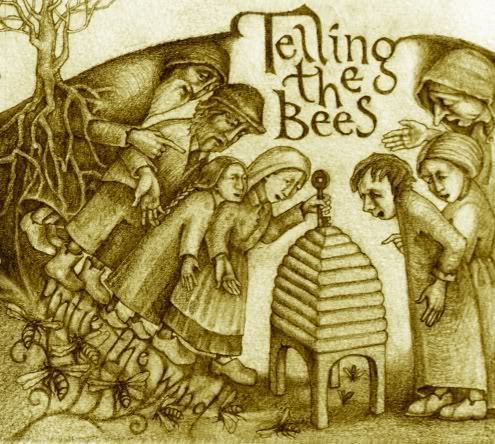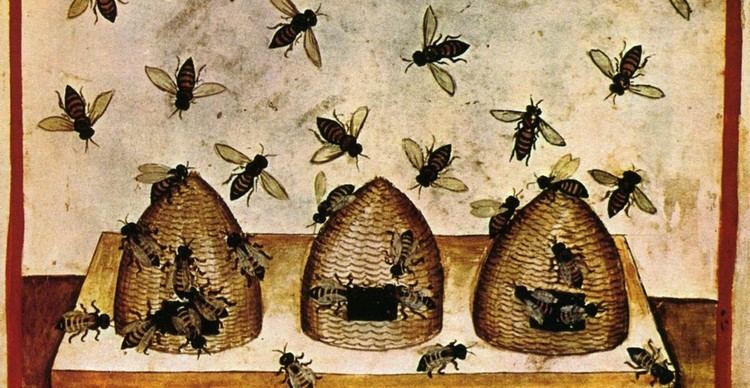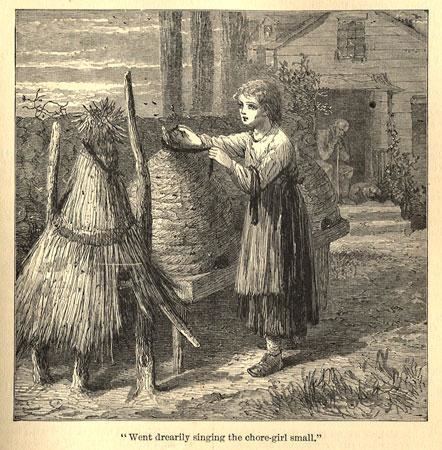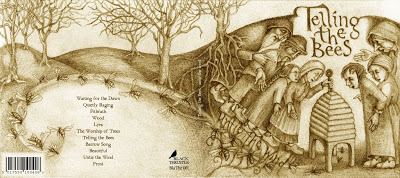 | ||
Telling the bees
The telling of the bees is a traditional European custom, in which bees would be told of important events in their keeper's lives, such as births, marriages, or departures and returns in the household. If the custom was omitted or forgotten and the bees were not "put into mourning" then it was believed a penalty would be paid, such as the bees might leave their hive, stop producing honey, or die. The custom has been most widely noted in England but also recorded in Ireland, Wales, Germany, Netherlands, France, Switzerland, and the United States.
Contents
- Telling the bees
- Worship of the trees by telling the bees
- History and origins
- Death and funerals
- Weddings
- In culture
- References

Worship of the trees by telling the bees
History and origins

Little is known about the origins of this practice, although there is some unfounded speculation that it is loosely derived from or perhaps inspired by ancient Aegean notions about bees' ability to bridge the natural world with the afterlife.
Death and funerals

Following a death in the household, there are several ways in which bees were to be informed and therefore put into proper mourning.

One approach from England would require the "goodwife of the house" to "hang the stand of hives with black, the usual symbol of mourning, she at the same time softly humming some doleful tune to herself." One such "tune" from Nottinghamshire had the woman (either a spouse or other caretaker) say "The master's dead, but don't you go; Your mistress will be a good mistress to you." Another similar oration recorded in Germany went "Little bee, our lord is dead; Leave me not in my distress."
Another method involved the male head of the household approaching the hive and knocking gently upon the hive until "the bees attention was thus secured" and then saying "in a low voice that such or such a person - mentioning the name - was dead. The key to the family home could also be used as a knocker.
One description from Carolina mountains of the United States says that "You knock on each hive, so, and say, 'Lucy is dead.'"
Bees could also be invited to the funeral.
In cases where the beekeeper had died, food and drink from the funeral would also be left by the hive for the bees, including the funeral biscuits and wine. The hive would also be lifted a few inches and put down again at the same time as the coffin. The hive might also be rotated to face the funeral procession, and draped with mourning cloth.
In some parts of the Pyrenees, one custom includes "burying an old garment belonging to the deceased under the bench where the bee-hives stand, and they never sell, give away, nor exchange the bees of the dead."
Should the bees fail to be told of a death in the family, "serious calamity" would follow not only for the family in question, but also for any person who was to buy the hive. For example, one record from Norfolk tells of a family who bought a hive of bees at auction from a farmer who had recently died and, because the bees had not been "put into mourning for their late master" they were "sickly, and not likely to thrive." However, when the new owners tied a "piece of crepe" to a stick and attached it to the hive, the bees soon recovered, an outcome that was "unhesitatingly attributed to their having been put into mourning."
Weddings
Although the practice of telling the bees is most commonly associated with funerals, there are also certain regions in which the bees are to be told of happy events of the family, particularly weddings.
In Westphalia, Germany, one custom held that newly married couples going to their new home must first introduce themselves to the bees or else "their married life will be unfortunate."
A 1950s article in the Dundee Courier Scotland, describes the practice of inviting bees to the wedding. If a wedding occurred in the household, the hive might be decorated, and a slice of wedding cake left by their hive.
The decoration of hives appears to date to the early 19th century.
One tradition in Brittany held that unless bee hives were decorated with scarlet cloth at a wedding and the bees allowed to partake in the rejoicing, they would go away.
In culture
The custom has given its name to poems by Deborah Digges, John Ennis, Eugene Field, and Carol Frost.
A section from John Greenleaf Whittier's poem "Home Ballads" describes the practice:
Before them, under the garden wall,
Forward and back
Went, drearily singing, the chore-girl small,
Draping each hive with a shred of black.
Trembling, I listened; the summer sun
Had the chill of snow;
For I knew she was telling the bees of one
Gone on the journey we all must go!
"Stay at home, pretty bees, fly not hence!
Mistress Mary is dead and gone!"
Several artists have captured this often solemn custom, perhaps most notably Charles Napier Hemy (1841-1917) in the image above, known both as The Widow and Telling the Bees.
